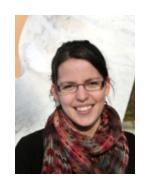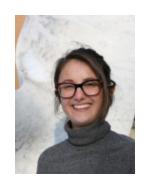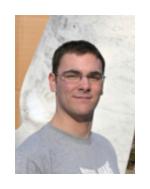Back at EPFL after a year in Harvard

© 2013 EPFL
Four students from EPFL completed their masters projects in Harvard Medical School labs thanks to the sponsorship of the Bertarelli Foundation. Here is a snapshot of their trip, featuring anecdotes and fascinating research in neuroscience.
Amélie, Elvira, Léonie and Nicolas, four students passionate about neuroscience, recently returned from a one-year stay in Boston, where they completed their masters projects at Harvard Medical School. Their work was sponsored by the Bertarelli Foundation, whose goal is to advance neuroscience by combining the skills of engineers and medical experts. Most of these young travelers are now doctoral assistants. They tell us about their experiences in America.
Improving auditory implants with lasers
Amélie Guex
Age: 25 years old
Performed her research at: Massachusetts Eye and Ear Infirmary Department of Otology and Laryngology
Master title: "Characterization of the Auditory System Responses to Infrared Neural Stimulation of the Cochlear Nucleus"
 What is special about Harvard?
What is special about Harvard?
Some laboratories headed by doctors or surgeons are set directly within hospitals. I worked in such a lab during my stay. It was part of a group of labs called the Eaton-Peabody Laboratories. I found it very motivating every day to come across patients who are likely to benefit from our technology.
As for the campus itself it was quite impressive, especially with all these red brick buildings. When I first saw it, I felt as if I were in a film.
What did you work on?
The lab in which I studied focuses on Implants for people who had their auditory nerve cut following the removal of a tumor, for example. The function of these implants - or small electrodes - is to stimulate the patients' brain stem, with the aim of helping them to recapture an auditory sensation. My mission consisted of testing an alternative method based on lasers. We wanted to see if optically-based methods could stimulate neurons more selectively than electrodes. I take a particular interest in neuroprosthetics and I greatly appreciated this research.
What did you think of American culture? Were you surprised?
The cosmopolitan city of Boston does not seem to be representative of the so-called "American culture". Some aspects of their lifestyle were surprising, though. Everybody follows the rhythm of huge events such as Halloween, Thanksgiving or the Superbowl. Also, some students in Boston participate in real Quidditch championnships which made us laugh (quidditch - fictional sport from the Harry Potter series). The team players run sideways with a broomstick between their legs and pass the ball. The Golden Snitch is personified by a guy wearing a yellow outfit, who holds a tennis ball. He has to hide most of the time.
Did this exchange open doors for you?
Yes, I'm now working on another project financially supported by the Bertarelli program. I've just started a thesis at the Laboratory for Soft Bioelectronic Interfaces (LSBI), headed by Stéphanie Lacour. We are exploring the possibility of developing flexible electrodes that can adapt more easily to the brain stem.
----
What happens in our brain while we are under a general anesthetic?
Elvira Pirondini
Age: 25 years old
Performed her research at: Massachusetts General Hospital Department of Anesthesia and Critical Care
Master title: "Sparse Priors and Empirically-Tailored Basis Sets For EEG Source Localization, Applied to Cross-Frequency Coupling under General Anesthesia"
 What is special about Harvard?
What is special about Harvard?
This is a great place. My supervisor - the Professor Emery Brown - was affiliated both to MIT and Harvard. I could therefore attend lots of talks and conferences in the two universities. In this respect, possibilities were more diversified than at EPFL. As for the quality of research and teaching, the level was quite similar, in my opinion.
What did you work on?
I was part of the team of the Neuroscience Statistics Research Laboratory that seeks to find out what is happening in the brain when patients are undergoing a general anesthetic. This question has not been answered yet. The group is formed by 50-60 people. They use several statistical methods and non-invasive techniques such as electroencephalography to unravel this mystery. The method consists of developing algorithms and models in order to depict brain activity. Personally, I was supposed to improve one of the existing algorithms that had been previously developed, following the brain observation of 10 patients under general anesthetic. My role was to speed up its computation to provide surgeons with a real-time estimation of the state of an anesthesia during surgery.
What did you think of American culture? Were you surprised?
In general, American people are very nice. I was surprised by the way television is omnipresent in their lives. A lot of discussions center around TV series. As for the education policy, I have the impression that people from Harvard are extremely specialized in their field, but if they wander away from their research, they have little knowledge. The situation is not similar at EPFL, a place where scientists seem more versatile.
Did this exchange open doors for you?
Yes. While participating at the Bertarelli Symposium in Boston, I got to know Sylvestro Micera, head of the Translational Neural Engineering Lab (TNE) at EPFL. Thanks to this encounter, I have now been able to start a thesis in this lab. My mission consists of observing the activity in the brain of stroke patients while they do exercises with the help of a robot.
At the end of the exchange, Emery Brown had suggested that I perform my thesis in Boston. However, I preferred to come back to EPFL. The quality of the research is equally high and I can be closer to my family, who live in Italy.
----
A detection of motor disorders in patients with Parkinson disease
Léonie Asboth:
Age: 23 years old
Performed her research at: Beth Israel Deaconess Medical Center (BIDMC) Department of Neurology
Master title: "Quantification of fine movement disorders in Parkinson's disease using a digitized tablet: turning experimental findings into a clinically simple diagnostic tool"
 What is special about Harvard?
What is special about Harvard?
Over the years, Harvard has progressively stretched to different places in Boston. Each space is devoted to a specific function. Built in a New-England style architecture, the "Harvard yard", for example, groups several dormitories and study areas for freshmen.
Hospitals affiliated to the Harvard Medical School as well as centers for medical research are located on the other side of the river, which is on the Boston side. This environment encourages translational research: the transfer of findings from Basic science to clinical test, as well as human care is facilitated.
As for education, I had the opportunity to attend a few lectures that were very proactive. Students kept trying debating different issues with professors.
What did you work on?
In the Center for Noninvasive Brain Stimulation of Boston, I was in charge of the development of a digitized tablet aimed at quantifying fine movement disorders related to Parkinson disease. We got the opportunity to test our technology with 20 people at different stages of the disease. Patients were asked to reproduce some pattern on the tablet, which recorded each tremor. We then proceeded to a kinematic and frequency movement-analysis. The results revealed some motor disorders that were invisible to the naked eye. We could objectively quantify inferred movements. This work was very simulating, because we developed a cheap and useful finished product that doctors could use every day. Moreover, this tool could prove useful to reduce the subjective aspects of neurological tests.
What did you think of American culture? Were you surprised?
I was astonished to see how easily Harvard students were able to put their innovative ideas into practice before the end of their studies. The launch of a startup is highly encouraged by professors. Harvard cultivates an entrepreneurial spirit among students from the very beginning of their studies. This is a major asset of American culture.
I was also surprised to see how extravagant Americans could be. While we were in Boston, they organized a contest where people were asked to swallow as many donuts as they could, before running a distance of 5 miles in less than an hour. We have also seen MIT students dressed as Star wars characters and performing "light saber" combats.
Did the exchange open doors for you?
Yes. I have discovered the lab in which I'm working right now through the Bertarelli program. It is called the IRP Chair in Spinal Cord Repair, headed by Grégoire Courtine. My thesis focuses on optogenetics, a method which consists of activating neuronal networks with light after genetically modifying the neurons. We want to understand the regeneration mechanism of the corticospinal projections in patients with spinal cord injury. The ultimate goal is to restore the ability to walk for paralyzed people.
----
Is rehabilitation through robotics efficient for everybody?
Nicolas Beuchat
Age: 23 years old
Performed his research at: Spaulding Rehabilitation Hospital Department of Physical Medicine and Rehabilitation
Master title: "Estimating Motor Adaptation Dynamics from the Force-Field Adaptation Paradigm using the Expectation-Maximization algorithm"
 What is special about Harvard?
What is special about Harvard?
This University is very lively and there is always something going on. Harvard is located next to the MIT and both universities are full of famous professors. Talks and conferences are numerous, as are research areas.
Moreover, as Leonie previously mentioned, Americans are more adventurous than we are, when it comes to the creation of a company. Failure is not stigmatized and more accepted than it would be in Switzerland.
What did you work on?
I was part of the Motion Analysis Laboratory which deals with rehabilitation through robotics with the help of exoskeletons, for example. Currently, the problem lies in the fact that robotic neurorehabilitation shows a large variability in its outcome in stroke patients. Some of them show very promising improvements in their motor skills whereas others show no improvement at all. In order to overcome this problem, I worked on a robotic platform devoted to predict which patient would respond positively to that kind of treatment. The tool took the shape of a lever that had to be pushed straightforward while a side force was applied. 14 patients were tested during my stay. I developed an algorithm to analyze the data collected by another laboratory. The aim was to assess patient motor learning and adaptation capabilities.
What did you think of American culture? Were you surprised?
In Switzerland, we hear plenty of prejudices about Americans and they do not apply to Boston. People are very much into sport in general, and during competitions, the show takes place both on the field and among the supporters, who often wear crazy outfits. During the basketball championship called March madness, my coworkers and I participated in a contest that consisted of predicting the result of every game during the championship. Of course, we didn't win.
Did the exchange open doors for you?
As a first step Yes. When I returned to EPFL I worked for a few months in José Millán's laboratory: the Chair in Non-Invasive Brain-Machine Interface (CNBI). Then I decided to take some time off, and to go travelling in South America. Argentina will be my first destination.
----
Additional information:
-Bertarelli's chairs at l'EPFL / Bertarelli Foundation / Bertarelli fellowship, Harvard